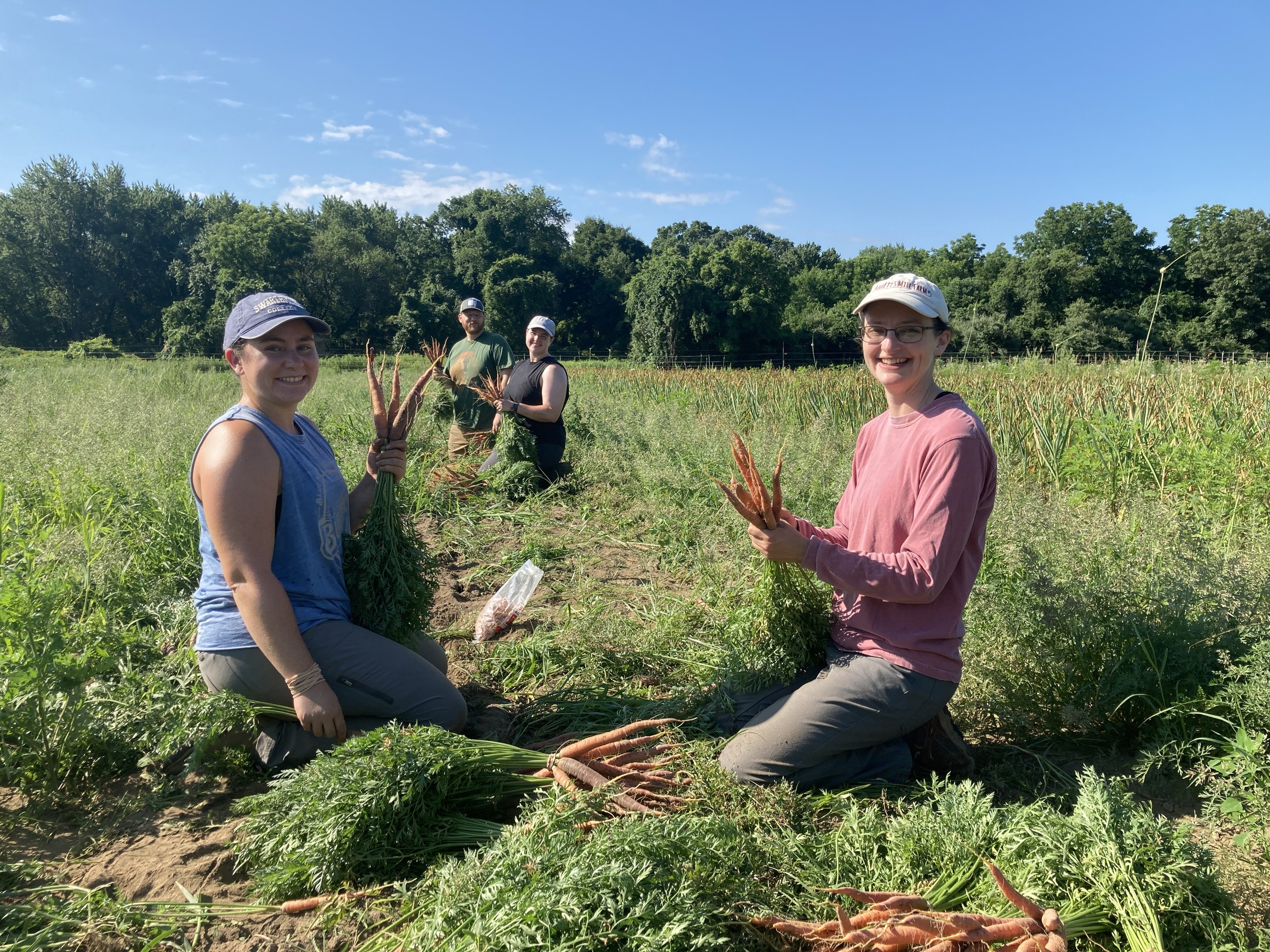We got to check off some pretty significant items on our task list last week in spite of taking a half day on July 4th. One of the items that has been weighing on our minds is trellising and pruning in our high tunnels. High tunnels are in-ground growing structures with a clear plastic “roof”, and as you might imagine it gets pretty hot in there on sunny summer days. This makes it a challenge to get high tunnel trellising work done in June and July! The morning is really the only tolerable time to be in there on a hot day, but that is also the time when we have to harvest vegetables so that they don’t wilt. Trellising is important for keeping plants off the ground and supporting them so that vines and branches don’t snap. Pruning the plants not only helps prevent branches and vines snapping, but it increases productivity, makes harvesting easier, and prevents disease because of better airflow.
The first round of trellising always takes the longest. We have to hang hundreds of new strings from the cross bars in the high tunnels, in addition to clipping plants to the strings and pruning them. Usually by the time we get to the last beds in the high tunnels the plants require extra pruning and gentle handling. Even once that is done, we still have to come back frequently throughout the summer (the plants grow rapidly in the high tunnels) to continue pruning and clipping plants to the trellising lines, but it generally moves quicker than that first round. Last week we finished our third or fourth round of cucumber trellising and we got most of the way through the first round of trellising our peppers. We thankfully got a little relief from the heat on Saturday, which allowed us to make some significant progress on the peppers.
It looks like we’ve got another hot and humid week out in the fields ahead of us, but we will still find time to get in the high tunnels. We are close to finishing the peppers…. for now! Next we desperately need to tackle the next round of high tunnel tomato trellising!
In the CSA this week:
Frisée - This is a slightly bitter leafy green that can add nice crunch to salads. It can also stand up to some wilting or sautéeing if you want to mellow the flavor.
Purple Carrots - The skins are both purple and orange, with orange interiors. They taste great and look pretty!
Slicing cucumbers
Thin-skinned seedless cucumbers
Zucchini
Summer Squash
Garlic Scapes
Kale
Mini Cabbage
Lettuce
Salanova lettuce mix - This cut leaf mix is a little crisper than a mesclun mix and therefore keeps well for longer!
Arugula 0r Mustard greens
Coming soon: potatoes, fresh onions, fennel and celery.
CSA Pick-Your-Own:
Green Beans
Sunflowers
Herbs: basil, dill, parsley, mint, oregano, chives and sage
In the farm store:
In addition to the items listed in the CSA, we will have:
Beets
Pickling Cucumbers
Seedlings
Flowers
Mushrooms from Fat Moon Farm - In addition to the regular Farmer’s Mix and Shiitake, we will have a few Lion’s Mane! Certified organic.
Baer’s Best Beans - Black Turtle variety is organic, the other varieties are not.
Warm Frisée and Mushroom Salad
from Tried & True
Ingredients
2 tablespoons plant-based or dairy butter plus more if needed
1 pound mixed mushrooms torn or sliced depending on the variety
3 shallots peeled and quartered lengthwise
2 tablespoons maple syrup
2 teaspoons Dijon mustard
2 teaspoons white wine vinegar
1 head of frisée torn
Salt and pepper to taste
Instructions
Cook the mushrooms:
Melt the butter in a wide pot or skillet over medium-high heat. Add half the mushrooms in an even layer and cook for 8–12 minutes until well-browned—season with salt and pepper and transfer to a bowl.
If the skillet is dry, add another tablespoon of butter. Once melted, add the remaining mushrooms and cook for 8–12 minutes. Season with salt and pepper and transfer to the bowl of mushrooms.
Cook the shallot:
Add the shallot to the pot and cook for 3–4 minutes, stirring often. Next, add all mushrooms to the pot and cook for 1–2 minutes.
Prepare the sauce:
Whisk together the maple syrup, Dijon mustard, and white wine vinegar in a bowl.
Cook the frisée:
Turn the heat on the mushrooms to high. Pour in the sauce and bring to a boil. Reduce heat to low and add the torn frisée. Cook for 5 minutes until wilted—season to taste with salt and pepper. Turn off the heat.
To serve:
Serve with cooked rice or noodles or alongside your favorite meat or plant-based protein. Enjoy!

